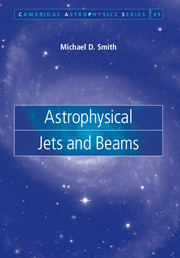Book contents
- Frontmatter
- Contents
- Preface
- 1 Introduction
- 2 Detection and measurement
- 3 The dynamical toolbox
- 4 Observations of extragalactic jets
- 5 Jets in galactic nuclei
- 6 Jets from young stars and protostars
- 7 Jets associated with evolved stars
- 8 Jets within the solar system
- 9 Jet launching
- 10 Jet propagation
- 11 The astrophysical jet
- References
- Index
6 - Jets from young stars and protostars
Published online by Cambridge University Press: 05 March 2012
- Frontmatter
- Contents
- Preface
- 1 Introduction
- 2 Detection and measurement
- 3 The dynamical toolbox
- 4 Observations of extragalactic jets
- 5 Jets in galactic nuclei
- 6 Jets from young stars and protostars
- 7 Jets associated with evolved stars
- 8 Jets within the solar system
- 9 Jet launching
- 10 Jet propagation
- 11 The astrophysical jet
- References
- Index
Summary
Directed flows of atoms and molecules are observed to stream away from young stars during their formation. Although the outflows are observationally prominent and suggest mass loss rather than gain, these early evolutionary stages are recognised as such by other signatures which indicate ongoing infall and mass accumulation. The infall continues from a surrounding envelope and through an accretion disc for the first few million years in the lifetime of a typical solar-mass or low-mass star, and probably on a shorter timescale for the formation of a massive star. At first, it appears paradoxical that infall should be so well signposted by outflow.
The accompanying outflow can take many forms besides that of a pair of highly supersonic antiparallel jets (Bally et al., 1996). Often no jet or only one jet may be detected. Quite often, only a partly collimated outflow is observed in the form of two diffuse lobes, expanding in opposite directions: a so-called bipolar outflow. Then, jets are not necessary but there is a choice between jets and collimated winds to provide the thrust and supply the energy to drive the two large-scale reservoirs. In yet other cases, compact shocked knots are moving directly away from the young star. Often arc-shaped, they are interpreted to be bow shocks driven by jet-like flows (or jets which have dissolved into a chain of bullet-like projectiles; see Bachiller (1996)).
- Type
- Chapter
- Information
- Astrophysical Jets and Beams , pp. 91 - 120Publisher: Cambridge University PressPrint publication year: 2012



